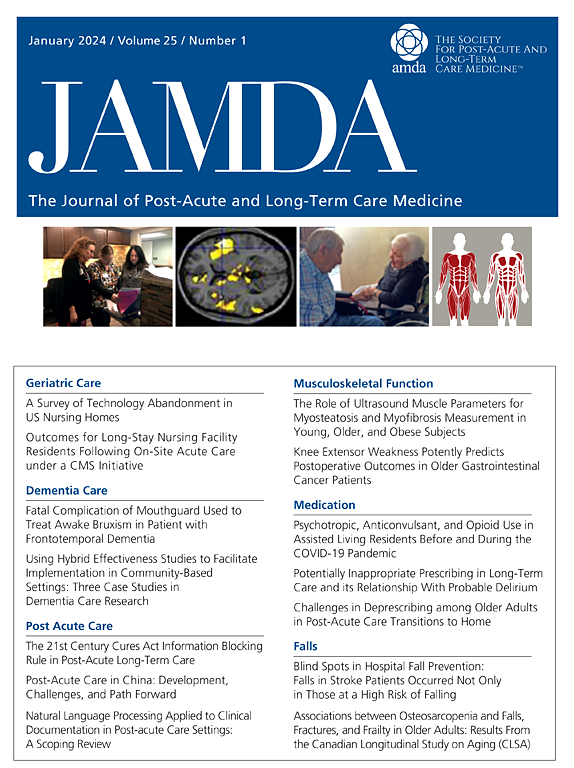长期护理中的个人档案痴呆症干预:阶梯式楔形分组随机试验。
IF 4.2
2区 医学
Q2 GERIATRICS & GERONTOLOGY
Journal of the American Medical Directors Association
Pub Date : 2025-01-01
DOI:10.1016/j.jamda.2024.105351
引用次数: 0
摘要
目的我们旨在评估以人为本的护理干预对改善长期护理机构中痴呆症患者生活质量(QoL)的效果:本研究是一项阶梯式楔形群组随机临床试验,即每月进行以人为本的结果测量,然后在护理人员和家庭成员的参与下进行由护士主导的个人档案协作干预,并与仅每月进行以人为本的结果测量进行比较:我们将瑞士德语区 23 家长期护理机构中被医学诊断为阿尔茨海默病或血管性痴呆或有痴呆临床症状的患者纳入研究对象:主要结果是 QoL,使用 QUALIDEM 进行评估。次要结果为 QUALIDEM 子量表和痴呆症患者姑息治疗综合结果量表子量表。研究为期 15 个月,采用线性混合效应模型进行分析:我们从 23 家长期护理机构招募了 240 名痴呆症患者。通过对 1143 个观察点进行建模,我们发现根据 QUALIDEM(95% CI,1.34-3.86;P < .001;QUALIDEM 干预总分:67;95% CI,64.8-69.1 vs 64.4;95% CI,62.3-66.4)。我们还发现干预对所有次要结果都有积极影响:基于以人为本的结果测量方法,每月一次的个人档案干预对 QoL 有着微小但显著的改善作用。因此,我们的研究结果表明,在长期护理机构中更广泛地实施有护理人员和家庭成员参与的个人档案干预具有潜在的益处。本文章由计算机程序翻译,如有差异,请以英文原文为准。
Person Profile Dementia Intervention in Long-Term Care: A Stepped-Wedge Cluster-Randomized Trial
Objectives
We aimed to assess the efficacy of a person-centered care intervention in improving quality of life (QoL) for people with dementia in long-term care facilities.
Design
This study was a stepped-wedge cluster-randomized clinical trial of monthly person-centered outcome measurements, followed by collaborative nurse-led person profile interventions involving nursing staff and family members, compared with monthly person-centered outcome measurements alone.
Setting and Participants
We included people with a medical diagnosis of Alzheimer's disease or vascular dementia or with clinical symptoms of dementia from 23 long-term care facilities in the German-speaking part of Switzerland.
Methods
The primary outcome was QoL, as assessed using the QUALIDEM. Secondary outcomes were the QUALIDEM subscales and the Integrated Palliative Care Outcome Scale for People with Dementia subscales. The study duration was 15 months, and linear mixed-effect models were used for the analysis.
Results
We recruited 240 people with dementia from 23 long-term care facilities. Modeling 1143 observations, we found a statistically significant positive intervention effect of 2.6 points according to the QUALIDEM (95% CI, 1.34–3.86; P < .001; total QUALIDEM intervention: 67; 95% CI, 64.8–69.1 vs 64.4; 95% CI, 62.3–66.4 for the control). We also found positive effects of the intervention on all secondary outcomes.
Conclusions and Implications
Once-a-month person profile interventions based on person-centered outcome measurements provided a small but significant improvement in QoL. Thus, our findings suggest a potential benefit to the broader implementation of person profiles involving nursing staff and family members in long-term care facilities.
求助全文
通过发布文献求助,成功后即可免费获取论文全文。
去求助
来源期刊
CiteScore
11.10
自引率
6.60%
发文量
472
审稿时长
44 days
期刊介绍:
JAMDA, the official journal of AMDA - The Society for Post-Acute and Long-Term Care Medicine, is a leading peer-reviewed publication that offers practical information and research geared towards healthcare professionals in the post-acute and long-term care fields. It is also a valuable resource for policy-makers, organizational leaders, educators, and advocates.
The journal provides essential information for various healthcare professionals such as medical directors, attending physicians, nurses, consultant pharmacists, geriatric psychiatrists, nurse practitioners, physician assistants, physical and occupational therapists, social workers, and others involved in providing, overseeing, and promoting quality

 求助内容:
求助内容: 应助结果提醒方式:
应助结果提醒方式:


